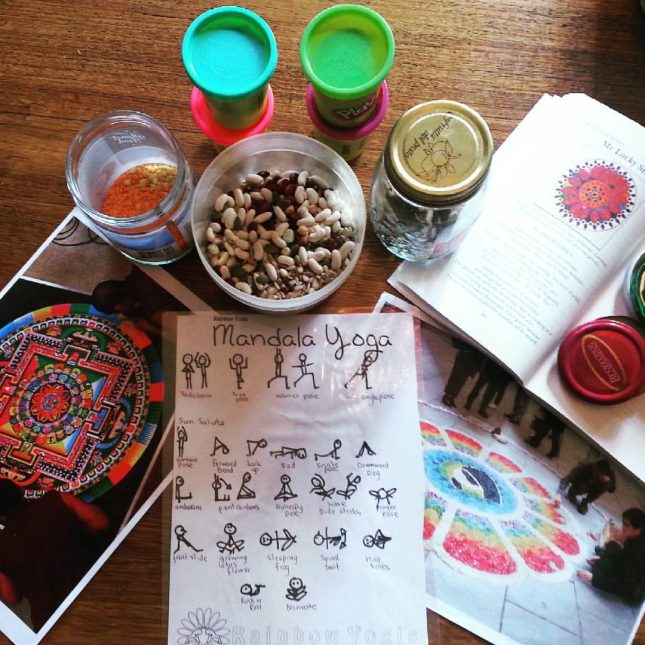Mandalas are traditionally a Tibetan Buddhist practice of non-attachment and non-permanence. These beautiful works of art are created by focus and concentration on stilling the mind and bringing the awareness to the breath and the present moment. This complete peacefulness becomes apart of the mandala and then eventually apart of the planet.
A mandala is traditionally made with very fine dyed sand. The sand is delicately tapped and scraped out of a metal funnel and tubes called chak-pur until the pattern heaps up. This can take many weeks to complete so sometimes the monks work together on this starting from the middle out.
After the mandala is created and many ceremonies have been performed around it, it is time for the monks to ritualistically dismantle the mandala. After the mandala has been broken down, the sand is put into a jar and taken to a moving body of water. It’s then released back out to nature, dispersed into the world, taking with it all the peaceful energy that was used in creating it in the first place.
The destruction of the mandala symbolises a letting go of our attachment to material things.
I teach mandala meditations to our little yogis in kids yoga. We use the ideas of non attachment and mindfulness in our class as we create our own mandalas. Mandalas can be used as great healing and focus tools for kids, helping with anxiety and building confidence, creating calmness and as a tool to help overcome stressful situations. Mandalas can be great for teaching kids to let go of the things that no longer serve them, while helping them understand that holding onto these things can be unhealthy. Letting go can be made understandable and fun.
Mandala ideas for kids yoga
- Firstly talk about the meaning behind creating a mandala. It’s important for the kids to understand the tradition and the background of the exercise before we start. This way the kids can have a better understanding as to why this project is important. They might start to find ways why this could work for them.

- Perform a Mandala yoga dance. Create a beautiful flow sequence of asanas that are practised together in a group in a circle. Use the group as the mandala circle, with poses you can do together whilst holding hands and creating amazing mandala shapes. Encourage mindful breathing. This can be practised over a few weeks to music and perhaps even performed in front of an audience. This exercise is great for building positive social and emotional behaviours, body awareness, confidence, focus, balance, co-ordination, strength and flexibility.

- Seed or nature Mandalas are a beautiful way to prepare the children for shavasana. Provide them with jar lids, play dough to press inside the lid and seeds to create the seed mandala into the dough. Encourage children to focus on their breath as they complete the project peacefully, sending happy thoughts into the mandala as they create it. Explain that other thoughts might come along whilst they create, and to acknowledge them with a secret smile then return their focus back to their breath. When they have finished creating something beautiful ask them to lay down in shavasana. Start to explain to them again the traditions of the mandala and how it is then disassembled and let go, to float down the river. Prepare them that this could be an option for their own mandala. Perhaps they would like to gift their mandala, passing on to another all the happy thoughts and goodness that was used in creating it. If they are not ready to give it away, then talk about how we can connect with our breath and think about how we would start to feel if we were to dismantle it and create a new one. This can be a practice in letting go and non attachment.

- Mindful colouring is an effective exercise to help create calm and stillness in the mind. Provide children with an outline of an already prepared mandala pattern. Provide art tools such as pencils and textas. Again encourage the children to focus on their breath and happy thoughts as they peacefully colour the mandala. Ask questions like how does this make you feel? How do certain colours make you feel? Or how does it make you feel when you watch the white paper turn to colour? You can even encourage them to write their happy thoughts around the mandala. This is a great exercise in helping kids connect with their breathe, to help them become still and present.

- Creating an original mandala can help further develop the focus and concentration needed to slow the mind and connect with the breath. Encourage the kids to follow their breath as they draw each line, being as creative as they like, reinforcing the happy thoughts. This is how a mandala can transport you to another world. Empowering the kids with reminders about this being a non-competitive project. Letting go of expectations and fears of perfection to allow the breath to guide the flow of the pencil. Just to be. At the end, for the older children, ask them to explain or write down how they felt before and after the creation of the mandala.

- For a fun environmentally aware mandala project, create a huge group mandala out of recycled materials. Finishing off with a calm and ceremonial deconstruction of the mandala, silently thinking of all the things you can let go of that no longer serves you. This project can also be done with nature, such as flowers, shells, rocks and leaves.

So as you can see, Mandalas are great tools for helping reduce stress and anxiety, making space for new more positive things to come and to help spread the loving kindness we all have inside of us.








